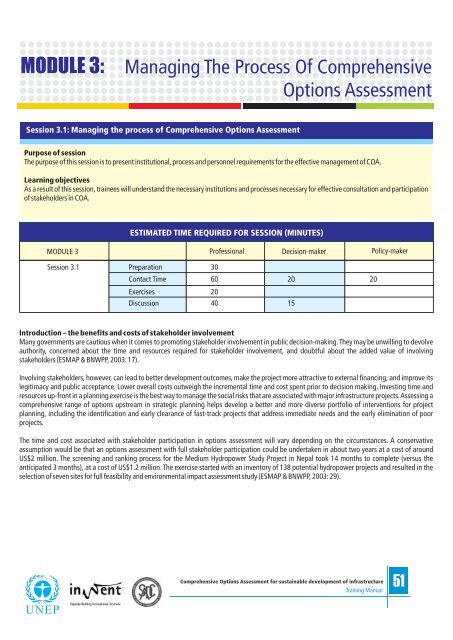Comprehensive Option Assesment - UNEP
Comprehensive Option Assesment - UNEP
Comprehensive Option Assesment - UNEP
You also want an ePaper? Increase the reach of your titles
YUMPU automatically turns print PDFs into web optimized ePapers that Google loves.
MODULE 3:<br />
Managing The Process Of <strong>Comprehensive</strong><br />
<strong>Option</strong>s Assessment<br />
Session 3.1: Managing the process of <strong>Comprehensive</strong> <strong>Option</strong>s Assessment<br />
Purpose of session<br />
The purpose of this session is to present institutional, process and personnel requirements for the effective management of COA.<br />
Learning objectives<br />
As a result of this session, trainees will understand the necessary institutions and processes necessary for effective consultation and participation<br />
of stakeholders in COA.<br />
ESTIMATED TIME REQUIRED FOR SESSION (MINUTES)<br />
MODULE 3 Professional Decision-maker Policy-maker<br />
Session 3.1<br />
Preparation<br />
30<br />
Contact Time<br />
60<br />
20<br />
20<br />
Exercises<br />
20<br />
Discussion<br />
40<br />
15<br />
Introduction – the benefits and costs of stakeholder involvement<br />
Many governments are cautious when it comes to promoting stakeholder involvement in public decision-making. They may be unwilling to devolve<br />
authority, concerned about the time and resources required for stakeholder involvement, and doubtful about the added value of involving<br />
stakeholders (ESMAP & BNWPP, 2003: 17).<br />
Involving stakeholders, however, can lead to better development outcomes, make the project more attractive to external financing, and improve its<br />
legitimacy and public acceptance. Lower overall costs outweigh the incremental time and cost spent prior to decision making. Investing time and<br />
resources up-front in a planning exercise is the best way to manage the social risks that are associated with major infrastructure projects. Assessing a<br />
comprehensive range of options upstream in strategic planning helps develop a better and more diverse portfolio of interventions for project<br />
planning, including the identification and early clearance of fast-track projects that address immediate needs and the early elimination of poor<br />
projects.<br />
The time and cost associated with stakeholder participation in options assessment will vary depending on the circumstances. A conservative<br />
assumption would be that an options assessment with full stakeholder participation could be undertaken in about two years at a cost of around<br />
US$2 million. The screening and ranking process for the Medium Hydropower Study Project in Nepal took 14 months to complete (versus the<br />
anticipated 3 months), at a cost of US$1.2 million. The exercise started with an inventory of 138 potential hydropower projects and resulted in the<br />
selection of seven sites for full feasibility and environmental impact assessment study (ESMAP & BNWPP, 2003: 29).<br />
<strong>Comprehensive</strong> <strong>Option</strong>s Assessment for sustainable development of infrastructure<br />
Training Manual<br />
51
















